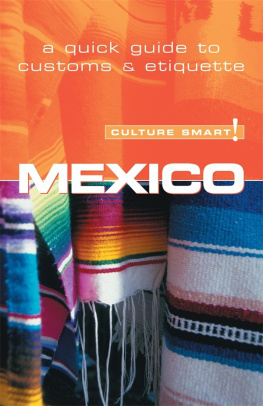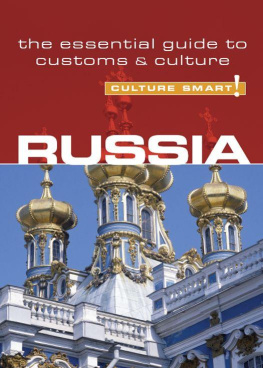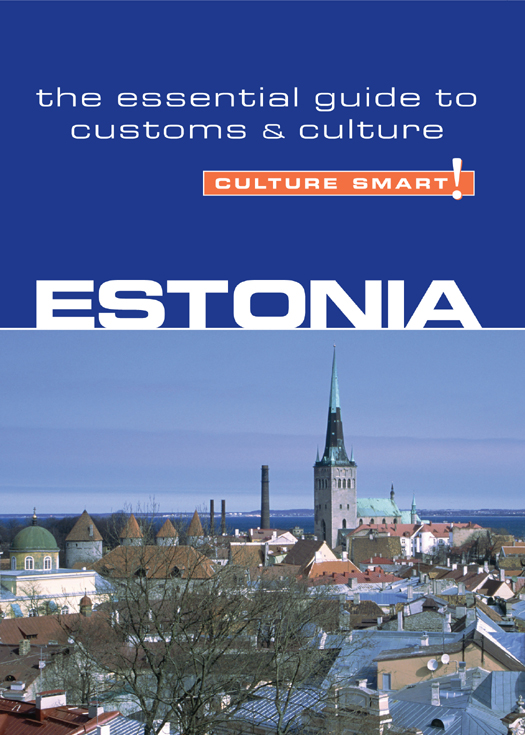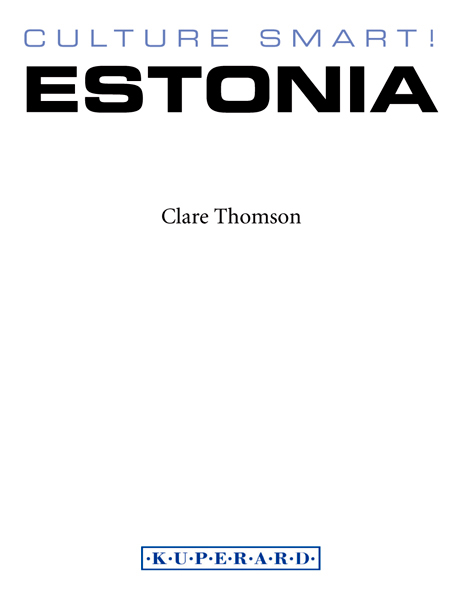First published in Great Britain 2007
by Kuperard, an imprint of Bravo Ltd
59 Hutton Grove, London N12 8DS
Tel: +44 (0) 20 8446 2440 Fax: +44 (0) 20 8446 2441
www.culturesmart.co.uk
Inquiries:
Culture Smart! is a registered trademark of Bravo Ltd
Copyright 2007 Kuperard
All rights reserved. No part of this publication may be reprinted or reproduced, stored in a retrieval system, or transmitted in any form or by any means without prior permission in writing from the publishers.
Series Editor Geoffrey Chesler
eISBN: 978-1-85733-616-0
: Tallinn, Estonia. Travel Ink/Robin McKelvie
Images ikescs
v3.1
About the Author
CLARE THOMSON, born in London to an Estonian mother and a Scottish father, is a journalist, travel writer, and teacher. She read English at Jesus College, Cambridge. Her first book was The Singing Revolution, an eye-witness account of the collapse of Communism in the Baltic States. Clare has worked as a journalist and freelance writer in Brussels and London. She has written and collaborated on several guidebooks about Belgium and the Baltics, and contributed articles to British newspapers, including the Times, the Independent, and the Sunday Times. She and her family are regular visitors to Tallinn.
The Culture Smart! series is continuing to expand.
For further information and latest titles visit
www.culturesmart.co.uk
The publishers would like to thank CultureSmart!Consulting for its help in researching and developing the concept for this series.
CultureSmart!Consulting creates tailor-made seminars and consultancy programs to meet a wide range of corporate, public-sector, and individual needs. Whether delivering courses on multicultural team building in the USA, preparing Chinese engineers for a posting in Europe, training call-center staff in India, or raising the awareness of police forces to the needs of diverse ethnic communities, it provides essential, practical, and powerful skills worldwide to an increasingly international workforce.
For details, visit www.culturesmartconsulting.com
CultureSmart!Consulting and CultureSmart! guides have both contributed to and featured regularly in the weekly travel program Fast Track on BBC World TV.
contents
Map of Estonia

introduction
For a nation of around 1.3 million inhabitants, Estonia has made a real impression on the world stage since regaining its independence less than two decades ago. In the mid-1980s, it was known, if at all, as a Soviet backwater, but the collapse of Communism saw the emergence of a republic determined to make up for lost time and establish itself as a forward-thinking Western state. The economy has been growing at a rate other nations can only observe with envy; the capital, Tallinn, has become a magnet for tourists and foreign investors alike; membership in the European Union and NATO has been achieved with ease; and Estonians have embraced the digital age with almost maniacal fervor.
At the same time, this is a nation distinct from its Baltic and Scandinavian cousins, with a language and culture very different from that of most European states. For all their love of Wi-Fi, entrepreneurship, and cell phones, Estonians are quiet and reserved, hardworking, fiercely jealous of their privacy, and lovers of nature. They can seem distant, almost rude on first meeting, but if you make the effort to get to know them, their sincerity and self-deprecating humor shine through. As one businessman who works in Tallinn observed, an Estonian friend is a friend for life. Adding flavor is the countrys substantial Russian-speaking community, something of a world unto itself, but more gregarious and outgoing than the natives.
If Estonian reserve can be in part attributed to five decades of Soviet occupation, and the consequences of not keeping your counsel, other aspects of the national character derive from the many occupations Estonia has endured, and the locals stubborn refusal to be subdued. Germans, Danes, Swedes, and Russians, both Tsarist and Soviet, have all had their turn at the reins over the centuries, and Tallinns time as a Hansa port has left its mark. Yet traditions run deep in this forested, sparsely populated land, and in the folk-inflected music that has become one of its international calling cards.
Culture Smart! Estonia aims to help you navigate these swirling waters. It is for any visitorwhether businessperson, student, or touristwho wants to understand Estonian society and encounter it with sensitivity and poise. We trace the countrys turbulent history and try to see how the past has shaped the collective and personal values of todays Estonians. We look at the Estonian people at work, at play, and at home, and offer tips to help you get along with Estonian colleagues and acquaintanceswithout any awkward silences!
Key Facts
| Official Name | Eesti Vabariik (Republic of Estonia) |
| Capital City | Tallinn | Pop. 400,000 |
| Main Cities and Towns | Tartu, Narva, Prnu, Viljandi, Rakvere |
| Area | 28,102 sq. miles (45,226 sq km). This includes 1,500 islands in the Baltic Sea. |
| Terrain | Flat, with large tracts of marshland and many lakes; heavily forested |
| Climate | Temperate |
| Currency | Kroon (EEK). The kroon is pegged to the euro at a rate of 15.65 EEK to 1 euro. |
| Population | 1.3 million.
Population density approx. 30 people/sq km (2007) |
| Ethnic Makeup | 67.9% Estonian, 25.6% Russian, 6.5% other. Other includes Ukrainians, Belarussians, and Finns. |
| National Languages | 67.3% Estonian, 29.7% Russian, 3% other. Estonian is the official langauge. |
| Religion | 13.6% Evangelical Lutheran, 12.8% Orthodox, 1.4% other Christian | Most Estonians do not belong to any religious organization. |
| Government | Parliamentary republic, with one legislative house, the Riigikogu | The country is divided into 15 counties. |
| Media | There are three domestic television channels: ETV, Kanal 2, and TV3. Finnish stations can be picked up. Cable channels available | Main newspapers: htuleht, Postimees, Eesti Express, riplev. There are two daily Russian-language papers: Molodjozh Estonii and Vesti Dnja. |
| Media: English-language | Some British and American newspapers are available, notably the Financial Times. | The weekly Baltic Times rounds up the weeks news in Estonia, Latvia, and Lithuania. |
| Electricity | 220 volts, 50 Hz. Standard European two-prong plugs are used. |






